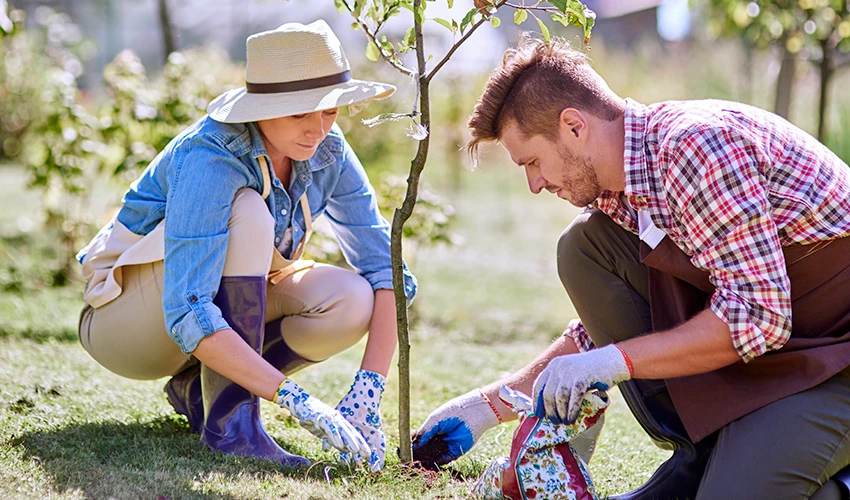
The Grounds Guys provide insights on selecting the best trees for your front yard.
|
Last Updated June 16, 2023
A strategic tree selection and placement can provide shade and privacy, increase your property value, and beautify your property. The key is to plant the right kinds of trees in the right places. So, what is the best tree to plant in your front yard? Since different trees thrive in different climates, first determine your hardiness zone. With that information in hand, view our lists below to decide on the best trees for your front yard.
Table of Contents:
Japanese Maple
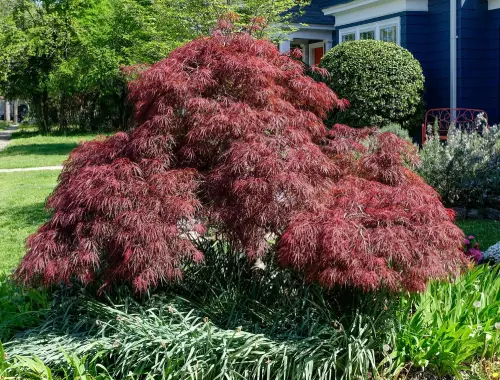
Japanese Maple Trees are some of the best trees to plant in your front yard. They offer a splash of rich, vibrant color that can last for months. With gorgeous hues of red, green, orange, white, pink, or purple, these trees bring the “wow” factor. Their average size ranges from 2 to 30 feet, and they will get established in your landscape within about two to three years.
These trees can have weeping, dwarf, upright, mounding, or cascading forms. Depending on the cultivar, they’re an excellent fit for a front entryway. Japanese Maple trees like to grow in areas with partial shade or full sun. However, growing them in a space with more shade can lead them to develop more vibrant foliage colors.
Japanese Maple Trees are easy to care for. They’ll grow well as long as the soil is drained properly. During the dry months, we suggest watering them deeply. Cut back on the amount of water you apply in late summer for intense fall colors.
Crape Myrtle
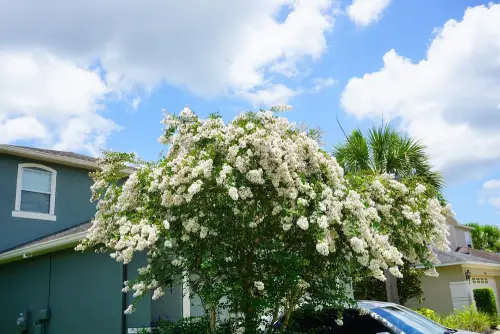
Plant a Crape Myrtle and enjoy a colorful display of flowers from late spring to early fall. Their dark green foliage is attractive too, and in the fall, it changes to shades of yellow, orange, and red. These are some of the best flowering trees for front yards and are best suited for growing in hot, sunny climates. The most common Crape Myrtle trees grow to a height of 15 to 25 feet, and they grow quickly. You won’t have to wait too long to enjoy the beautiful attributes that this smaller-sized tree brings to your yard.
Crape Myrtle trees grow well in the sun. Since their roots are non-invasive, feel free to place them next to a sidewalk, in a bed of flowers, or as a stand-alone focal point in the front yard. If you want to create privacy, plant a few of them together, and you’ll have a colorful privacy hedge in no time. Caring for these trees is a breeze. Just be sure to plant them in an area with at least six hours of direct sunlight. While they prefer moist, well-drained soil, they also have some drought tolerance.
Dogwood
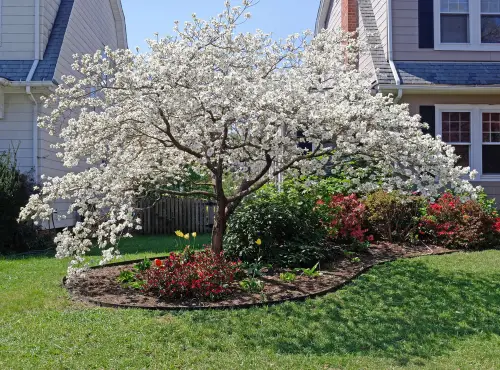
Dogwood trees can be one of the best trees for front yard landscaping. These small, deciduous trees bloom a stunning display of white or pink flowers in spring. Their foliage is also attractive, with leaves that change from green in the summer to a reddish-purple hue during fall. They have a fast growth rate with an average size ranging from 10 to 25 feet.
Dogwoods like both the sun and shade, so you can plant them near the shrubs next to your driveway and enjoy a gift of color when you leave and come home in the springtime. They’re also great understory trees, so feel free to plant them in a shady spot near a window to enjoy these attractive trees all year.
Since they have naturally shallow roots, water them properly while they’re being established. Allow the water to penetrate the soil deeply to help the roots grow fast and healthy.
Flowering Cherry
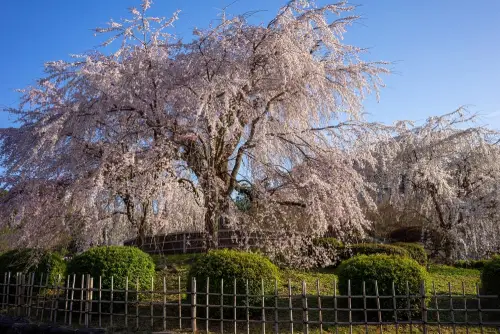
The showy Flowering Cherry tree bursts a stunning display of pink and white spring blossoms. They have a moderate growth rate and can grow to 30 feet tall when mature. Their canopy can be just as wide, so choose a location in the front yard that can support its size.
These are some of the best trees for front yards. You can use them as a focal point or plant them near a driveway. Flowering Cherry trees are sure to add curb appeal no matter where you plant them in your landscape.
A Flowering Cherry tree doesn't need much care; however, you’ll want to water it thoroughly after it’s been planted and until it’s established. These trees aren’t too picky about soil type and can grow well in full sun, partial shade, or mostly shade. Pruning can help improve air and light circulation, and removing any dead or diseased branches is always a good idea.
Redbud
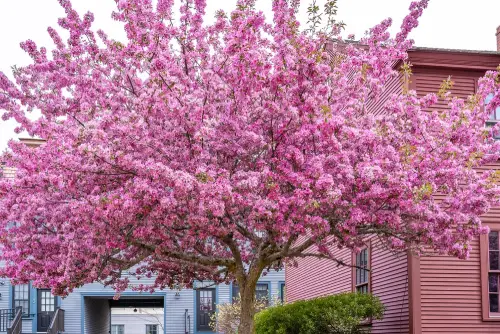
Redbud trees are some of the best trees for the front of your house. Vibrant purple-pink flowers appear in early spring, and their reddish-purple leaves put on a show when they transform from dark green to yellow. They have a medium growth rate and can reach a height of up to 30 feet when mature. They also have a wide canopy to provide much-needed shade during hot and sunny days.
We suggest planting them as an accent tree or near a fence. Their irregular branching, stylish crown, and flowers are sure to be a focal point during their blooming season.
These low-maintenance trees appreciate full sun and partial shade, so about four hours of direct sunlight will do. You’ll want to keep the soil moist while the tree establishes, but don’t oversaturate the soil.
Fringe Tree
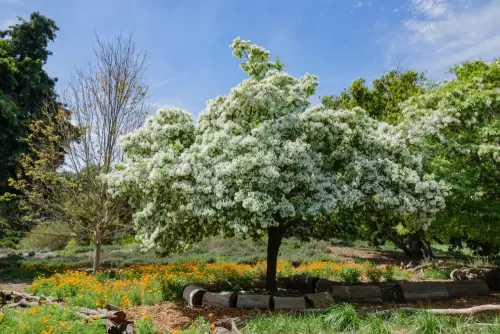
The fringe tree is a slow-growing tree that can grow up to 20 feet tall. These are some of the best flowering trees for the front yard because they can bloom delicate creamy white flowers that don’t just look beautiful; they smell lovely too.
You can plant them as a backdrop, and they complement any garden. They’re an excellent choice near a terrace or patio, where you can sit back, relax, and appreciate their blooms at close range.
Fringe trees like to be grown in an area with full sun or partial shade and have a moderate need for water to tolerate some drought.
Best Small Trees for a Front Yard
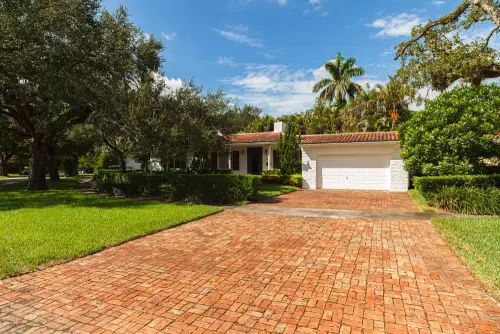
If you don’t have much space but still want to add beauty to your small front yard, opt for an ornamental tree. These species are known for their flowers and fruit in the spring and beautiful foliage in the fall. Here are some of our favorites:
- Serviceberry (Zones 2-9)
- Crabapple (Zones 3-8)
- Chinese Dogwood (Zones 3-8)
- Japanese Maple (Zones 5-8)
- Weeping Cherry (Zones 5-8)
- Redbud (Zones 5-9)
- Saucer Magnolia (Zones 5-9)
- Citrus tree (Zones 8-11)
- Smoke tree (Zones 4-8)
- Riverbirch (Zones 4-9)
Best Shade Trees for a Front Yard
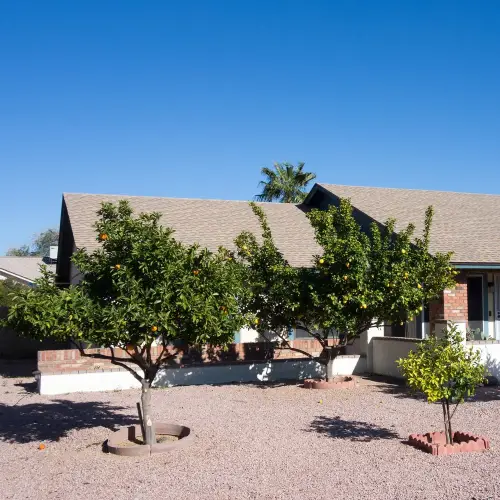
Do you envision sitting under a large shade tree in your front yard? If so, you need one that will mature into a tall, striking tree with a large canopy. Keep in mind that shade trees take years to fill in and require regular pruning to maintain a healthy shape and size. Our top picks include:
- Oak tree (Zones 3-10, depending on the variety)
- Larger Maples (Zones 3-9, depending on the variety)
- Golden Rain tree (Zones 6-9)
Best Trees for Front Yard Privacy
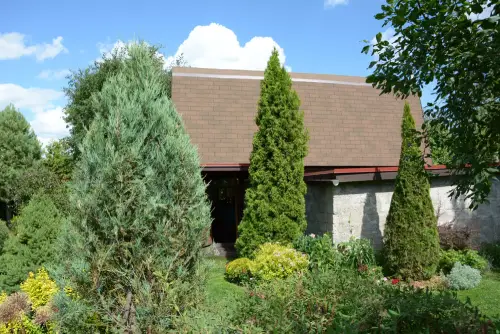
The ideal way to achieve a natural privacy screen is with compact conifers. Some of the best options for this purpose include:
- Arborvitae (Zones 2-7)
- Spruce (Zones 2-8, depending on the variety)
- Pine (Zones 2-10, depending on the variety)
Adding trees to your property, especially your front yard, improves your landscaping, benefits the environment, and adds value to your home. However, choosing the best trees for front yards is only part of the process; you also have to plant and care for them properly to ensure they provide enjoyment for many years to come. Contact The Grounds Guys today for more information on incorporating trees into your landscape. Our experts stand by the Neighborly Done Right Promise®, which means your satisfaction is always guaranteed.
FAQs About Best Front Yard Trees
Our 200 franchise locations across the U.S. and Canada share a common goal — use our years of experience and expertise to help you bring the vision for their property to life. This includes answering questions you have about landscaping and lawn care. Below are answers to some of the most frequently asked questions about the best trees for your front yard.
What are the most popular ornamental trees to enhance curb appeal?
Japanese Maple, Crape Myrtle, and Flowering Cherry trees consistently rank as top choices for front yard curb appeal. Japanese Maples offer vibrant colors in red, green, orange, white, pink, or purple that last for months, making them instant attention-grabbers. Their compact size (2-30 feet) makes them perfect for front entryways.
Crape Myrtles provide colorful flower displays from late spring through early fall, with blooms in various shades and attractive fall foliage. They're particularly striking when planted in groups to create a colorful privacy hedge.
Flowering Cherry trees create spectacular spring displays with pink and white blossoms that can span up to 30 feet wide when mature. These trees serve as excellent focal points and work beautifully near driveways or as standalone specimens.
For smaller spaces, Serviceberry and Crabapple trees are excellent ornamental choices, offering both spring flowers and attractive fruit, while Saucer Magnolias provide large, showy blooms that create dramatic visual impact.
Which trees are best for providing front yard privacy without blocking sunlight?
Arborvitae stands out as the premier choice for front yard privacy screens that still allow sunlight filtration. These compact conifers grow in narrow, upright forms that create effective barriers without overwhelming smaller spaces or completely blocking light to your home.
Crape Myrtles planted in groups offer an innovative privacy solution. Their non-invasive root systems allow close planting, and their naturally open branching structure filters light while providing seasonal privacy. During winter, they allow more light through when deciduous leaves drop.
Spruce trees provide year-round privacy with varying densities depending on the species. Norway Spruce offers denser coverage, while Blue Spruce has a more open structure that allows some light penetration between branches.
Pine trees like Eastern White Pine create soft, natural privacy screens. Their needle structure filters light rather than blocking it completely, and their growth habits can be managed through proper pruning to maintain desired light levels.
The key is selecting the right species for your hardiness zone and considering mature size when planning placement to ensure adequate sunlight reaches your home's windows and lawn areas.
Are there any low-maintenance trees suitable for small front yards?
Japanese Maples top the list for low-maintenance small front yard trees. They require minimal care once established. Simply ensure proper drainage and provide deep watering during dry periods. Their slow to moderate growth means less frequent pruning, and they naturally maintain attractive shapes.
Fringe Trees are exceptionally low-maintenance, growing slowly to just 20 feet while producing fragrant white flowers. They tolerate partial shade and have moderate water needs with some drought tolerance once established.
Redbud trees offer vibrant spring flowers and fall color with minimal care requirements. They need only four hours of direct sunlight daily and prefer consistently moist (not oversaturated) soil during establishment.
For extremely small spaces, consider dwarf varieties of larger species:
- Dwarf Japanese Maples stay under 8 feet
- Dwarf Crabapples provide flowers and fruit in compact forms
- Weeping Cherry varieties offer dramatic form without excessive size
Serviceberry deserves special mention for small yards. It is native to many regions, requires virtually no care once established, provides spring flowers, summer berries that attract birds, and brilliant fall color. This tree adapts to various soil types and light conditions, making it nearly foolproof for beginning gardeners.
Most ornamental trees become low-maintenance after their first 2-3 years of establishment when their root systems develop fully.
This article is intended for general informational purposes only and may not be applicable to every situation. You are responsible for determining the proper course of action for your home and property. The Grounds Guys are not responsible for any damages that occur as a result of this blog content or your actions. For the most accurate guidance, contact The Grounds Guys location nearest you for a comprehensive, on-site assessment.